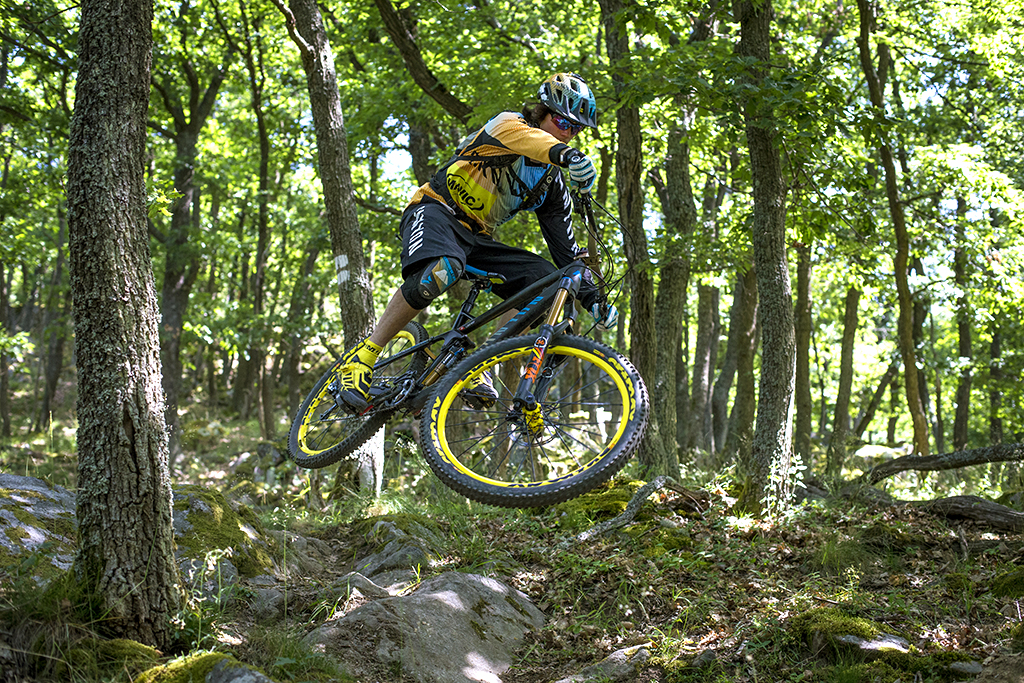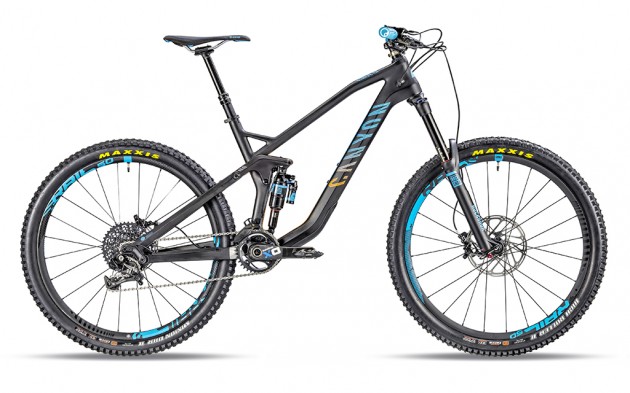Shape-shifting Strive CF gets innovative on-the-fly travel and geometry adjustment
What’s a Shapeshifter? Sounds like something from a science-fiction film…
It might sound like science fiction, but Canyon’s new Shapeshifter system is engineering reality. While on-the-fly travel and geometry adjustment is nothing new (think Bionicon, and to a certain extent Scott and Cannondale), Canyon has come at the idea from a completely fresh perspective. Push a remote lever on the handlebar (similar to a seatpost remote), to actuate a small piston hidden behind the suspension linkage, and the Shapeshifter design effectively moves the position of the top shock mount by 15mm. This changes the head angle (and seat angle) by 1.5º, the bottom bracket height by 19mm and the travel by 24mm.
Of course the Shapeshifter does add some extra weight (200g according to Canyon) and complexity, but the piston only moves when you switch between the two modes and, as such, gets used less than a dropper post. The benefits are three-fold:
- In the DH mode the Strive CF is configured for confident descending on the fastest and most technical alpine terrain. That means a fairly slack head angle and a low bottom bracket. Switch to XC mode and the head angle and seat angle steepen – making it more efficient on long or steep climbs – and the bottom bracket is raised. That means less chance of clipping your pedals on rocks and ruts.
- Reducing the travel also improves efficiency on climbs and out-of-the-saddle sprints, but there’s still plenty of grip and traction on flatter singletrack or rough ascents. In full travel mode you have 163mm of super-active suspension and a bike that can be kept pinned on the roughest rock gardens.
- By altering the angle of the shock in relation to the linkage, the kinematics change. Although progressive in both modes, the XC mode has a firmer end stroke and makes the bike feel a lot more responsive to pedal inputs.
How do you move between modes?
Let’s say you want to go from XC mode to DH mode. Firstly stand up out of the saddle, then push the cable-operated remote lever on the bars. With the lever depressed, drop your heels down and kick your feet forward. Couple that with a slight rearward shift of your weight and the piston retracts and the shock moves back towards the seat tube.
To get into XC mode, press the lever and rise forward out of the saddle sharply, as though you are unweighting the rear wheel to roll up a curb. Both movements soon become second nature and take little effort to induce. A small window in the rocker link turns green in XC mode and black in DH to confirm the switch.
You can tune how much effort is neeeded to switch between modes by changing the air pressure of the Shapeshifter piston. More pressure engages XC mode more easily, less pressure creates a bias to the DH position.
Is this system unique to the new Strive CF?
At the moment the Shapeshifter is only found on the new Strive CF 160mm enduro bike, but Canyon did indicate that other long travel models might also benefit from the application of this technology.
What about the rest of the bike? Don’t you always complain that Canyon’s are a bit on the small side?
That’s right, we have criticised Canyon for the compact nature of its frames. But the German brand has been working hard with Fabien Barel for the last 18-months and it was almost inevitable that his preference for long, slack stable bikes would start to influence geometry. The surprising part is, Canyon has decided to introduce two frame lengths – Regular and Race. All the angles are the same, the chainstay lengths are identical, but the front centre (and top tube/reach/down tube) grows by 20mm. There are four Regular frame sizes (S/M/L/XL) and three Race sizes (S/M/L). Race bikes also get single-ring drivetrains, while the Regular bikes use multi-ring gearing.
The full carbon frames are pretty light, at 2.4kg with Shapeshifter but no shock. It’s Reverb Stealth compatible, gets moulded chainstay and downtube protectors, a bottle cage mount, chainsuck plate and internal cable routing.
How does it ride?
Look out for our first ride in the August issue of MBR magazine. On sale in July.
Is the Strive CF as good value as the rest of the Canyon range?
Well, for a full carbon frame, RockShox Pike RCT3, RockShox Monarch Plus shock, XO1 drivetrain, Reverb Stealth, Renthal bar and stem and Maxxis High Roller 2 tyres, you’re looking at £3,699. That’s a pretty good deal in anyone’s book. The range starts at £3,199 and goes up to £4,299.
Can I buy one in a shop?
No, they key to Canyon’s low prices is that it sells direct to the consumer via its website. You have to order the bike, get it shipped to your home or work and assemble it yourself. The new Strive CF is available to buy now, but delivery isn’t due until August. For more details visit Canyon.com






